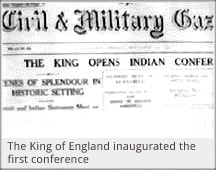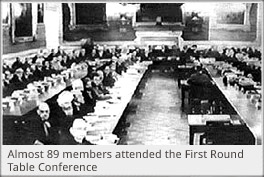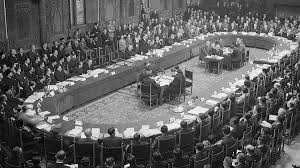The Indian political community received the Simon Commission Report issued in June 1930 with great resentment. Different political parties gave vent to their feelings in different ways.
The Congress started a Civil Disobedience Movement under Gandhi’s command. The Muslims reserved their opinion on the Simon Report declaring that the report was not final and the matters should decided after consultations with the leaders representing all communities in India .The Indian political situation seemed deadlocked. The British government refused to contemplate any form of self-government for the people of India. This caused frustration amongst the masses, who often expressed their anger in violent clashes.
 The Labor Government returned to power in Britain in 1931, and a glimmer of hope ran through Indian hearts. Labor leaders had always been sympathetic to the Indian cause. The government decided to hold a Round Table Conference in London to consider new constitutional reforms. All Indian politicians; Hindus, Muslims, Sikhs and Christians were summoned to London for the conference.
The Labor Government returned to power in Britain in 1931, and a glimmer of hope ran through Indian hearts. Labor leaders had always been sympathetic to the Indian cause. The government decided to hold a Round Table Conference in London to consider new constitutional reforms. All Indian politicians; Hindus, Muslims, Sikhs and Christians were summoned to London for the conference.
Gandhi immediately insisted at the conference that he alone spoke for all Indians, and that the Congress was the party of the people of India. He argued that the other parties only represented sectarian viewpoints, with little or no significant following.
First Round Table Conference
The first session of the conference opened in London on November 12, 1930. All parties were present except for the Congress, whose leaders were in jail due to the Civil Disobedience Movement. Congress leaders stated that they would have nothing to do with further constitutional discussion unless the Nehru Report was enforced in its entirety as the constitution of India.
Almost 89 members attended the conference, out of which 58 were chosen from various communities and interests in British India, and the rest from princely states and other political parties. The prominent among the Muslim delegates invited by the British government were Sir Aga Khan, Quaid-i-Azam, Maulana Muhammad Ali Jouhar, Sir Muhammad Shafi and Maulvi Fazl-i-Haq. Sir Taj Bahadur Sapru, Mr. Jaikar and Dr. Moonje were outstanding amongst the Hindu leaders.
The Muslim-Hindu differences overcastted the conference as the Hindus were pushing for a powerful central government while the Muslims stood for a loose federation of completely autonomous provinces. The Muslims demanded maintenance of weightage and separate electorates, the Hindus their abolition. The Muslims claimed statutory majority in Punjab and Bengal, while Hindus resisted their imposition. In Punjab, the situation was complicated by inflated Sikh claims.
Eight subcommittees were set up to deal with the details. These committees dealt with the federal structure, provincial constitution, franchise, Sindh, the North West Frontier Province, defense services and minorities.
The conference broke up on January 19, 1931, and what emerged from it was a general agreement to write safeguards for minorities into the constitution and a vague desire to devise a federal system for the country.
Gandhi-Irwin Pact
 After the conclusion of the First Round Table Conference, the British government realized that the cooperation of the Indian National Congress was necessary for further advancement in the making of the Indian constitution. Thus, Lord Irwin, the Viceroy, extended an invitation to Gandhi for talks. Gandhi agreed to end the Civil Disobedience Movement without laying down any preconditions.
After the conclusion of the First Round Table Conference, the British government realized that the cooperation of the Indian National Congress was necessary for further advancement in the making of the Indian constitution. Thus, Lord Irwin, the Viceroy, extended an invitation to Gandhi for talks. Gandhi agreed to end the Civil Disobedience Movement without laying down any preconditions.
The agreement between Gandhi and Irwin was signed on March 5, 1931. Following are the salient points of this agreement:

- The Congress would discontinue the Civil Disobedience Movement.
- The Congress would participate in the Round Table Conference.
- The Government would withdraw all ordinances issued to curb the Congress.
- The Government would withdraw all prosecutions relating to offenses not involving violence.
- The Government would release all persons undergoing sentences of imprisonment for their activities in the civil disobedience movement.
The pact shows that the British Government was anxious to bring the Congress to the conference table.
Second Round Table Conference
The second session of the conference opened in London on September 7, 1931. The main task of the conference was done through the two committees on federal structure and minorities. Gandhi was a member of both but he adopted a very unreasonable attitude. He claimed that he represented all India and dismissed all other Indian delegates as non-representative because they did not belong to the Congress.
The communal problem represented the most difficult issue for the delegates. Gandhi again tabled the Congress scheme for a settlement, a mere reproduction of the Nehru Report, but all the minorities rejected it.
As a counter to the Congress scheme, the Muslims, the depressed classes, the Indian Christians, the Anglo-Indians, and the Europeans presented a joint statement of claims which they said must stand as an interdependent whole. As their main demands were not acceptable to Gandhi, the communal issue was postponed for future discussion.
 Three important committees drafted their reports; the Franchise Committee, the Federal Finance Committee and States Inquiry Committee.
Three important committees drafted their reports; the Franchise Committee, the Federal Finance Committee and States Inquiry Committee.
On the concluding day, the British Prime Minister, Ramsay MacDonald appealed to the Indian leaders to reach a communal settlement. Failing to do so, he said, would force the British government would take a unilateral decision.
Quaid-i-Azam did not participate in the session of the Second Round Table Conference as he had decided to keep himself aloof from the Indian politics and to practice as a professional lawyer in England.
On his return to India, Gandhi once again started Civil Disobedience Movement and was duly arrested.
Third Round Table Conference
 The third session began on November 17, 1932. It was short and unimportant. The Congress was once again absent, so was the Labor opposition in the British Parliament. Reports of the various committees were scrutinized. The conference ended on December 25, 1932.
The third session began on November 17, 1932. It was short and unimportant. The Congress was once again absent, so was the Labor opposition in the British Parliament. Reports of the various committees were scrutinized. The conference ended on December 25, 1932.
 The recommendations of the Round Table Conferences were embodied in a White Paper. It was published in March 1933, and debated in parliament directly afterwards, analyzed by the Joint Select Committee and after the final reading and loyal assent, the bill reached the Statute Book on July 24, 1935.
The recommendations of the Round Table Conferences were embodied in a White Paper. It was published in March 1933, and debated in parliament directly afterwards, analyzed by the Joint Select Committee and after the final reading and loyal assent, the bill reached the Statute Book on July 24, 1935.
This article was last updated on Sunday, June 01, 2003[/fusion_text][/fusion_builder_column][/fusion_builder_row][/fusion_builder_container]






